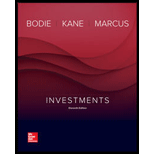
Investments
11th Edition
ISBN: 9781259277177
Author: Zvi Bodie Professor, Alex Kane, Alan J. Marcus Professor
Publisher: McGraw-Hill Education
expand_more
expand_more
format_list_bulleted
Concept explainers
Question
Chapter 12, Problem 21PS
Summary Introduction
To determine: The TRIN statistics for 1 day
Introduction: TRIN is the trading index or arms Index. It is usually calculated as the ratio of number of issues in advances with the number of declining issues. The index is a simple moving average.
Expert Solution & Answer
Want to see the full answer?
Check out a sample textbook solution
Students have asked these similar questions
For pueblo super market in st thomas usvi
What is the methodology that capital markets serve as engines of economic growth and innovation? Could you help explain how methodology is critical to successful of the capital market?
How are they also vulnerable to significant structural and behavioral problems?
What are the appropriate uses of a qualitative single case study, and what types of research are best suited for the study of capital markets?
What is the research framework of the capital market?
What is the purpose of the Capital Markets?
What are the qualitative research questions that Capital Markets seek to understand or explain, while quantitative research questions seek to relate or measure?
What could be the problems of Capital Markets, and how can the problems of Capital Markets be solved?
How can the practice or issue be improved?
Chapter 12 Solutions
Investments
Ch. 12 - Prob. 1PSCh. 12 - Prob. 2PSCh. 12 - Prob. 3PSCh. 12 - Prob. 4PSCh. 12 - Prob. 5PSCh. 12 - Prob. 6PSCh. 12 - Prob. 7PSCh. 12 - Prob. 8PSCh. 12 - Prob. 9PSCh. 12 - Prob. 10PS
Ch. 12 - Prob. 11PSCh. 12 - Prob. 12PSCh. 12 - Prob. 13PSCh. 12 - Prob. 14PSCh. 12 - Prob. 15PSCh. 12 - Prob. 16PSCh. 12 - Prob. 17PSCh. 12 - Prob. 18PSCh. 12 - Prob. 19PSCh. 12 - Prob. 20PSCh. 12 - Prob. 21PSCh. 12 - Prob. 22PSCh. 12 - Prob. 23PSCh. 12 - Prob. 24PSCh. 12 - Prob. 25PSCh. 12 - Prob. 1CPCh. 12 - Prob. 2CPCh. 12 - Prob. 3CPCh. 12 - Prob. 4CPCh. 12 - Prob. 5CP
Knowledge Booster
Learn more about
Need a deep-dive on the concept behind this application? Look no further. Learn more about this topic, finance and related others by exploring similar questions and additional content below.Similar questions
- What are the obstacles to work through emotional wellness coping methods, and increasing self-understanding, and how to work through them? What are the advantages and disadvantages of emotional wellness, coping methods, and increasing self-understanding?arrow_forwardWhat is the present value of $10,000 to be received in 5 years, assuming a discount rate of 10%?A) $6,210B) $6,810C) $7,580D) $8,100arrow_forwardDepreciation is:a) The increase in the value of an asset over time.b) The allocation of the cost of a tangible asset over its useful life.c) An amount paid for the maintenance of an asset.d) An asset's market value at the end of the accounting period.arrow_forward
- Depreciation is:a) The increase in the value of an asset over time.b) The allocation of the cost of a tangible asset over its useful life.c) An amount paid for the maintenance of an asset.d) An asset's market value at the end of the accounting period. Need helparrow_forwardWhat is the corporate finance how this is the part of finance?arrow_forwardExplain! Which of the following represents the primary goal of financial management?A) Maximizing net incomeB) Maximizing shareholder wealthC) Minimizing costsD) Maximizing market sharearrow_forward
- Which of the following represents the primary goal of financial management?A) Maximizing net incomeB) Maximizing shareholder wealthC) Minimizing costsD) Maximizing market sharearrow_forwardExplain! Which of the following is an example of a capital budgeting decision?A) Determining how to finance a new projectB) Deciding whether to pay dividends to shareholdersC) Deciding whether to purchase a new piece of equipmentD) Managing the company's cash balancesarrow_forwardExplain What does a beta coefficient of 1.5 indicate for a stock?A) The stock is less volatile than the marketB) The stock has no correlation with the marketC) The stock is 50% more volatile than the marketD) The stock is 50% less volatile than the marketarrow_forward
- What does a beta coefficient of 1.5 indicate for a stock?A) The stock is less volatile than the marketB) The stock has no correlation with the marketC) The stock is 50% more volatile than the marketD) The stock is 50% less volatile than the marketarrow_forwardWhat is the formula for calculating the net present value (NPV) of an investment?A) Future Cash Flows × Discount RateB) Present Value of Cash Inflows - Initial InvestmentC) Internal Rate of Return - Discount RateD) Net Income / Initial Investmentarrow_forwardWhich of the following is an example of a capital budgeting decision?A) Determining how to finance a new projectB) Deciding whether to pay dividends to shareholdersC) Deciding whether to purchase a new piece of equipmentD) Managing the company's cash balancesarrow_forward
arrow_back_ios
SEE MORE QUESTIONS
arrow_forward_ios
Recommended textbooks for you
 Managerial AccountingAccountingISBN:9781337912020Author:Carl Warren, Ph.d. Cma William B. TaylerPublisher:South-Western College Pub
Managerial AccountingAccountingISBN:9781337912020Author:Carl Warren, Ph.d. Cma William B. TaylerPublisher:South-Western College Pub

Managerial Accounting
Accounting
ISBN:9781337912020
Author:Carl Warren, Ph.d. Cma William B. Tayler
Publisher:South-Western College Pub
Stockholders Equity: How to Calculate?; Author: Accounting University;https://www.youtube.com/watch?v=2jZk1T5GIlw;License: Standard Youtube License